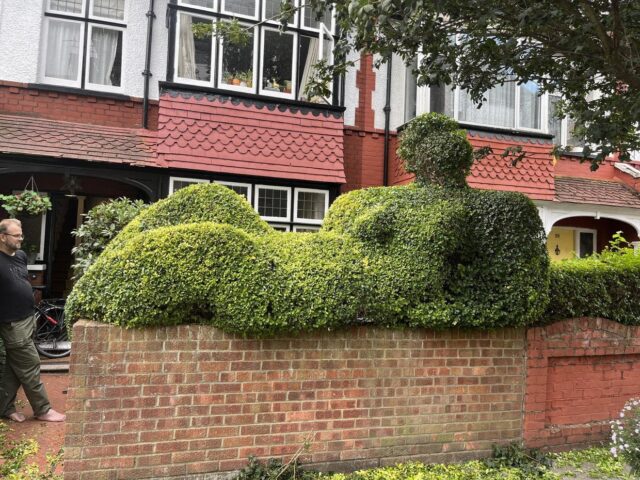When Tim Bushe, a 70-year-old architect and art college graduate, decided to trim his hedges one evening, his efforts attracted more than just curious glances. Passersby paused to take photos, neighbors expressed their gratitude, and a driver honked in approval.
This attention wasn’t new for Mr. Bushe; it happens every time he prunes his two enormous, leafy elephants. These elephants are part of a larger menagerie of topiary animals he has sculpted from overgrown hedges in his north London neighborhood.
A Garden Of Delight
Mr. Bushe’s collection includes a variety of playful shapes: two cats, a squirrel, a hippo, and even a reclining nude woman. His ambition is to add a giant rabbit to this whimsical assortment soon. The hedges have not only delighted locals but have also become minor landmarks, attracting reviews on Google Maps ranging from straightforward praise to enthusiastic declarations of life-changing beauty.
A Labor Of Love
Bushe’s journey into topiary began about 15 years ago with a hedge in his own front yard. His late wife, Philippa, had requested a cat sculpture, but Bushe initially created a train instead, followed by a monster head. These creations spurred requests from neighbors, and soon his talent for transforming hedges into art became widely recognized.
Creating these intricate shapes is a lengthy process, often taking three years or more to achieve the desired form. “I could end up with one ear, for instance, and have to wait years for the other ear to grow,” Bushe explained. Unlike traditional sculptures, these living artworks require regular maintenance to retain their form, making the task increasingly challenging as he ages.
The Roots Of Topiary
Topiary, the art of shaping hedges, has ancient origins in Britain, dating back to the Bronze Age. It gained popularity during the 18th-century agricultural revolution and continues to symbolize a well-kept home and garden. Guy Barter, a chief horticulturist at the Royal Horticultural Society, notes that hedges thrive in Britain’s climate and provide essential shelter for buildings, people, farms, and livestock.
In recent times, more whimsical and flamboyant hedges have gained favor, reflecting the personality and creativity of their owners. Tim Alden, a friend inspired by Bushe’s work, sculpted his hedge into the shape of a dog, much to the delight of his neighbors.
A Community Treasure
Bushe’s topiaries have become a source of joy and community pride. Simon Massey, a local resident, praised the hedges as “a wonderful bit of art,” while Abdirashid Obsiye, a science teacher, humorously reviewed the dog-shaped hedge as “an inspired piece” online.
Despite the challenges of maintaining these living sculptures, including threats from pests and disease, Bushe’s hedges continue to bring smiles and a touch of whimsy to north London. “Why not do something playful once in a while,” Alden reflected, “for no reason other than it makes us smile?”
References:
The New York Times: You See a Hedge. He Sees Something Else.
CBS News: Why a London man named Bushe is on a mission to turn his neighbors’ hedges into art
Royal Horticultural Society: Hedges
The Topiary Garden at Levens Hall








